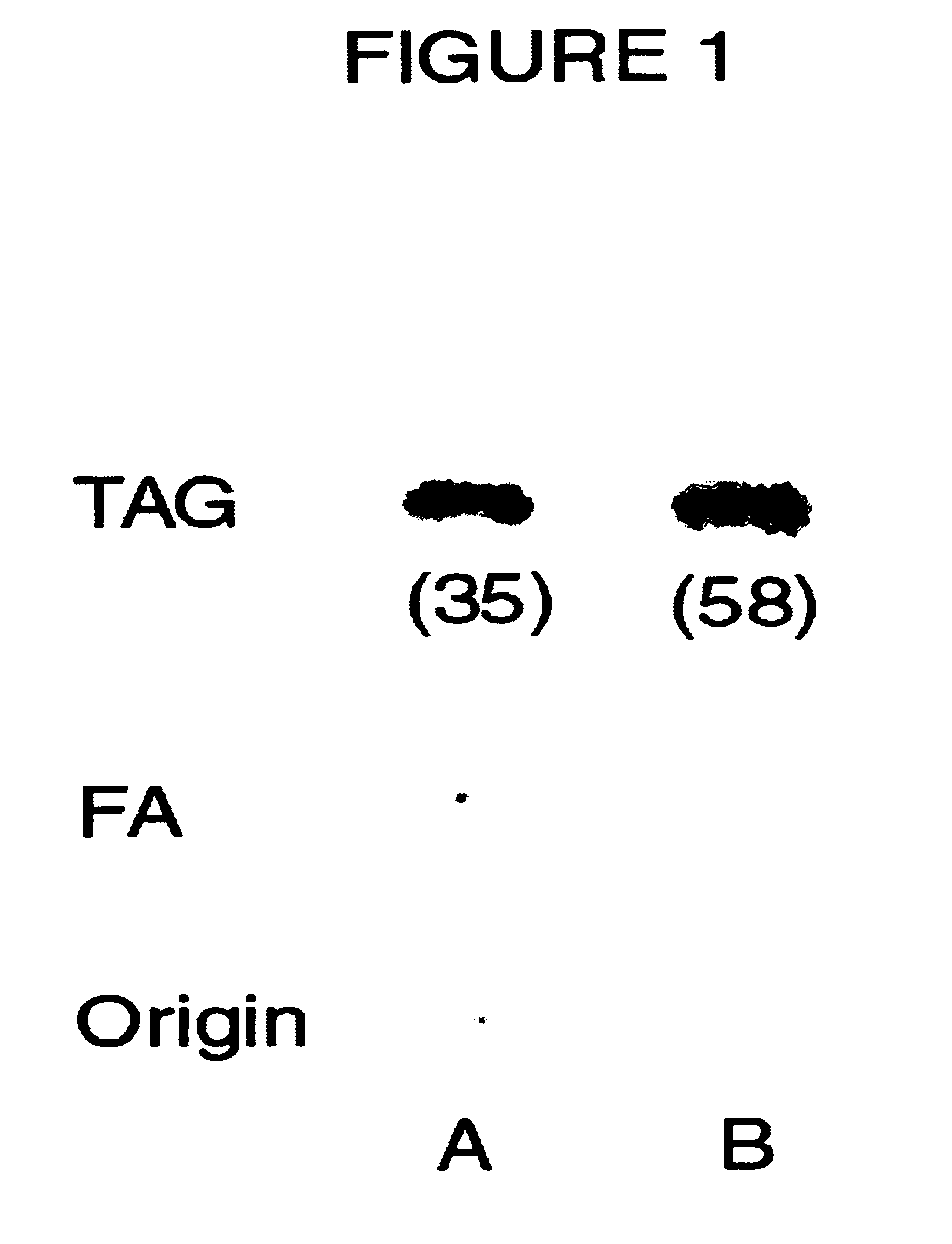Use of a class of enzymes and their encoding genes to increase the oil content in transgenic organisms
a technology of transgenic organisms and enzymes, applied in the field of transgenic organism oil content increase, can solve problems such as inability to classify, and achieve the effect of increasing the oil content of the organism
- Summary
- Abstract
- Description
- Claims
- Application Information
AI Technical Summary
Benefits of technology
Problems solved by technology
Method used
Image
Examples
example 1
Triacylglycerol accumulation is reduced in yeast cells that lack the ARE1 gene.
Materials and Methods
Yeast strains. Yeast strains used in this study were congenic to the W303-1A (Thomas & Rothstein, 1989) background. An are1 mutant strain, H1111, with the genotype MAT.alpha. are1-.DELTA.::IIIS3 ADE2 can 1-100 leu2-3, 112 trip1-1 ura3-1, was generated by crossing the two strains SCY60 (MAT.alpha. are1-.DELTA.::IIIS3 ade2-1 can 1-100 leu2-3, 112 trp1-1 ura3-1) and SCY61 (MAT.alpha. are2-.DELTA.::LEU2 ADE2 can 1-100 his3-11,15 trp1-1 ura3-1) (Yang et al., 1996) and dissecting tetrads. As a wild type control, we used SCY62 (MAT.alpha. ADE2 can 1-100 his3-11,15 leu2-3 trp1-1 ura3-1) (Yang et al., 1996). Yeast mutant strains disrupted in YNR008w and YOR245c encoding yeast DAGAT B and PDAT, respectively, and the ARE1 gene were constructed through a series of yeast transformations using the lithium acetate method. Linear DNA fragments used for the disruption of the YOR245c and YNR008w genes ...
example 2
Triacylglycerol accumulation is increased in yeast cells that overexpress the ARE1 gene.
Material and Methods
For induced overexpression of the ARE1 gene, a 2001 bp EheI / Ecl136II fragment from the plasmid YEP 3-16 (Yang et al., 1996) was cloned into the BamHI site of the GAL1 expression vector pHN92 (Ronne et al., 1991), thus generating pUS5. The wild type yeast strain SCY62 (MAT.alpha. ADE2 can 1-100 his3-11,15 leu2-3 trp1-1 ura3-1) (Yang et al., 1996), was transformed with the pUS5 and cultivated at 28.degree. C. on a rotary shaker in synthetic medium (Sherman et al., 1986) lacking uracil and supplemented with 2% (vol / vol) glycerol and 2% (vol / vol) ethanol. The GAL1 promoter was induced after 43 h of growth by the addition of 2% (wt / vol) final concentration of galactose. Cells were harvested after an additional 24 hours of growth. Wild type (SCY62) cells transformed with the empty vector, pJN92, and cultivated under identical conditions were used as a control. The lipid content of t...
example 3
The ARE1 gene product has diacylglycerol acyltransferase activity.
Materials and Methods
In vitro diacylglycerol acyltransferase (DAGAT) activity was analyzed, in microsomal fractions prepared from yeast cells, by using one of the following methods.
Method A: A wild type yeast (strain SCY62) was transformed with a plasmid (pUS5) containing the ARE1 gene under the control of a GAL1 promoter (described in Material and Methods in Example 2). The transformed yeast was cultivated at 28.degree. C. in defined YNB medium lacking uracil. The expression of the ARE1 gene was inducted by the addition of 2% (v / v) galactose after 8 hours growth and the cells were harvested after an additional 17 hours. Microsomal membranes were prepared from the transformed yeast by resuspending 1 g of yeast (fresh weight) in 8 ml of ice-cold buffer (20 mM Tri-Cl, pH 7.9, 10 mM MgCl.sub.2, 1 mM EDTA, 5% (v / v) glycerol, 1 mM DTT, 0.3 M ammonium sulphate) in a 12 ml glass tube to which 4 ml of glass bends (diameter 0....
PUM
| Property | Measurement | Unit |
|---|---|---|
| pH | aaaaa | aaaaa |
| pH | aaaaa | aaaaa |
| weight | aaaaa | aaaaa |
Abstract
Description
Claims
Application Information
 Login to View More
Login to View More - R&D
- Intellectual Property
- Life Sciences
- Materials
- Tech Scout
- Unparalleled Data Quality
- Higher Quality Content
- 60% Fewer Hallucinations
Browse by: Latest US Patents, China's latest patents, Technical Efficacy Thesaurus, Application Domain, Technology Topic, Popular Technical Reports.
© 2025 PatSnap. All rights reserved.Legal|Privacy policy|Modern Slavery Act Transparency Statement|Sitemap|About US| Contact US: help@patsnap.com


